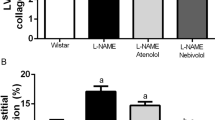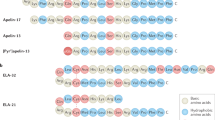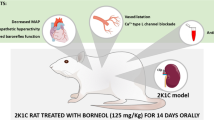Abstract
Cyclosporin-induced hypertension is a major complication of immunosuppression in transplant recipients but its pathophysiology is only partly understood. Cyclosporin reduces endothelium-dependent vasodilation and increases endothelin synthesis and release, which may contribute to this hypertension. We examined the effects of: (1) nitric oxide enhancement with L-arginine administration and antagonism with N-nitro-L-arginine; and (2) chronic endothelin receptor blockade with the non-peptide endothelin receptor antagonist, bosentan, in two animal models of cyclosporin-induced hypertension. Cyclosporin, administered daily to female Wistar rats (10 mg/kg per day for 30 days, s.c.) and to marmosets (30 mg/kg per day for 20 days, p.o.) significantly elevated tail cuff systolic blood pressure (BP). L-arginine (250 mg/kg, in saline, i.p.), N-nitro-L-arginine (25 mg/kg, in saline, i.p.), bosentan (100 mg/kg, in arabic gum, p.o.) or vehicle were given daily to the rats during the last week of cyclosporin treatment. Marmosets received L-arginine (300 mg/kg, in water, p.o.), bosentan (100 mg/kg/day in arabic gum, p.o.) or vehicle for the last 7 days of cyclosporin treatment. L-arginine, but not saline alone significantly lowered BP in the cyclosporin-hypertensive rats from 129 ± 2 mm Hg to 122 ± 3 mm Hg (P < 0.05), and cyclosporin-hypertensive marmosets from 156 ± 2 mm hg to 139 ± 4 mm hg (P < 0.01). nola significantly increased systolic bp in cyclosporin-treated (from 133 ± 2 mm hg at week 3 to 142 ± 3 mm hg, P < 0.05) and control rats (from 124.0 ± 2 mm hg to 134 ± 2 mm hg, P < 0.05) indicating that nitric oxide synthesis in cyclosporin-hypertensive rats could be further antagonised. bosentan, but not arabic gum alone, also lowered bp in the cyclosporin-hypertensive rats from 134 ± 1 mm hg to 122 ± 3 mm hg (P < 0.01), and cyclosporin-hypertensive marmosets from 156 ± 2 mm hg to 139 ± 4 mm hg (P < 0.01). these results support the roles of both increased endothelin synthesis and decreased nitric oxide activity in the pathogenesis of cyclosporin a-induced hypertension.
This is a preview of subscription content, access via your institution
Access options
Subscribe to this journal
Receive 12 digital issues and online access to articles
$119.00 per year
only $9.92 per issue
Buy this article
- Purchase on Springer Link
- Instant access to full article PDF
Prices may be subject to local taxes which are calculated during checkout
Similar content being viewed by others
Author information
Authors and Affiliations
Rights and permissions
About this article
Cite this article
Bartholomeusz, B., Hardy, K., Nelson, A. et al. Modulation of nitric oxide improves cyclosporin A-induced hypertension in rats and primates. J Hum Hypertens 12, 839–844 (1998). https://doi.org/10.1038/sj.jhh.1000709
Published:
Issue Date:
DOI: https://doi.org/10.1038/sj.jhh.1000709
Keywords
This article is cited by
-
Upregulation of vasopressin V1A receptor mRNA and protein in vascular smooth muscle cells following cyclosporin A treatment
British Journal of Pharmacology (2001)



